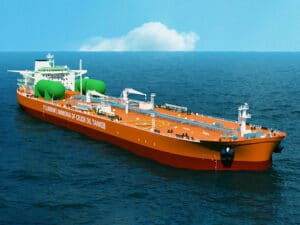
Op-Ed: Maritime shift to eco-friendly propulsion in 2024
Written by Heather Ervin
Tuomas Riski
By Tuomas Riski, CEO, Norsepower
As we ease our way into 2024, it’s clear that the winds of change are blowing through the maritime industry. Norsepower, a global provider of mechanical sails for large ships, is at the helm of this transformation. The previous year, 2023, wasn’t just another year in our calendar; it was a landmark in normalizing wind as a sustainable source of propulsion power for ships.
The shipping industry finds itself at a pivotal moment where the focus has shifted from questioning the viability of wind propulsion to discussing scalability and partnerships. This evolution is driven not solely by regulatory pressures such as CII and EU-ETS but also significantly by surging customer demand for greener shipping solutions. Across the globe, companies are actively seeking ways to decarbonize their supply chains, a trend reflected in the growing adoption of Norsepower Rotor Sails on numerous bulk ships and tankers.
While the cost of carbon and the implications of the EU ETS have been instrumental in driving this change towards seeking greater fuel savings, 2024 must see a broader narrative. Our conversation needs to move beyond fiscal considerations to the essence of wind propulsion — an inexhaustible, accessible, and carbon-neutral decarbonization solution. Norsepower Rotor Sails are a testament to this approach, demonstrating significant fuel savings and emphasizing the synergy between commercial viability and environmental stewardship.
In this critical year, as we confront the urgent challenges of tightening regulations, rising fuel prices and geopolitical complexities, the maritime sector still has the opportunity to be the master of its own destiny and we are seeing the winds of change growing stronger. For example, there is a tangible shift in the industry, from interest to action with the Norsepower Rotor Sail installations more than doubling within 18 months. As part of this, the dialogue around wind propulsion is also changing. It’s no longer a question of ‘why’ ship owners and their charterers should invest in our system, but more about ‘how’ we can deploy this technology at scale across fleets.
Looking at the market, accurate like-for-like comparisons of different wind propulsion solutions are difficult to make due to each fleet’s unique nuances such as route, size, cargo, and frequency. However, we actively encourage conversations around the importance of proven performance data, as providers must have the credentials to back up their efficiency and safety claims. With a robust track record of installations since 2014, we can provide customers with data on our Norsepower Rotor Sail, which already has over 310,000 operating hours and has reduced more than 20,100 tons of CO2 emissions; most other providers can’t offer this reassurance.
For years, Norsepower has focused on choosing the right partners to facilitate this shift, integrating wind propulsion seamlessly with existing technologies, and overcoming financial barriers to encourage widespread adoption. We recognize that this is not a journey we embark on alone; it requires collaboration across the industry, with shipbuilders, operators, and cargo owners all playing a vital role.
Our approach is not just about embracing a new technology; it’s about adopting a new mindset. It’s about understanding that environmental sustainability and commercial success are not mutually exclusive but can go hand-in-hand!
The Norsepower Rotor Sail has already started making a tangible difference by reducing fuel consumption and emissions from 5% to 25%, and even more in good conditions, showcasing the practicality of wind propulsion in shipping.
2024 will be the year when wind propulsion takes its rightful place as a cornerstone technology in maritime transport. As we chart our course through 2024 and beyond, we must embrace not only the technological advancements but also the cultural shift towards sustainability in the sector. Norsepower’s journey exemplifies how innovation and sustainability can drive the industry forward. By adopting wind propulsion products like our Norsepower Rotor Sail, the maritime industry can bring sails back to shipping, reduce its carbon footprint and pave the way for a cleaner, more sustainable future. This year is about making a bold statement – that the maritime industry is not only ready for change but is actively leading the charge in environmental responsibility.




